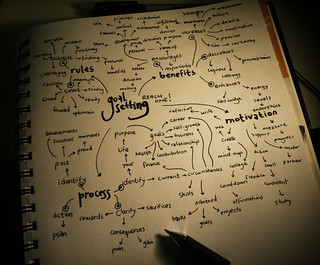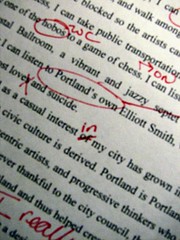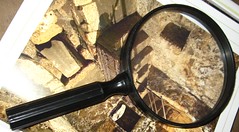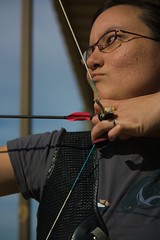I learned the concept of scene goals when I read Jack Bickham’s Scene & Structure. Simply, a scene goal is the character’s immediate goal at the outset of a scene. But it’s amazing how this very simple concept can strengthen your fiction.
Finding scene goals
 We mentioned scene goals last week in scene charts. As I forced myself to write out the character’s immediate goal at the outset of the scene, I found that sometimes the character didn’t know what his or her immediate purpose was. The scenes that lacked a goal for the character (or a unique goal, as opposed to one that the character’s had four times now) were often the unfocused scenes I needed the most work on—or to be cut altogether.
We mentioned scene goals last week in scene charts. As I forced myself to write out the character’s immediate goal at the outset of the scene, I found that sometimes the character didn’t know what his or her immediate purpose was. The scenes that lacked a goal for the character (or a unique goal, as opposed to one that the character’s had four times now) were often the unfocused scenes I needed the most work on—or to be cut altogether.
The goal of a scene should be very, very obvious to the writer, the reader and the character. In fact, in Scene & Structure, Jack Bickham says that our POV characters should state their goals for that scene fairly early on.
The prototypical scene begins with the most important character—invariably the viewpoint character—walking into a simulation with a definite, clear-cut, specific goal which appears to be immediately attainable. This goal represents an important step in the character’s game plan—something to be obtained or achieved which will move him one big step closer to the attainment of his major story goal. . . . (24)
The scene begins with a stated, clear-cut goal. (25)
Scene goals are fantastic for structuring fiction at this level because they tell us, the writers, what needs to happen. Our character arrives at the car dealership with the mission to buy a car/talk to his ex-girlfriend/flirt with the new salesguy. (It sets up the “scene question,” if you will: will s/he get this goal?) The character works toward that goal, until the disaster, as Bickham calls it. We answer the scene question with, most likely, a “no” or a “yes, but [complication].” (Just plain yesses should be reserved for false victories, lulling characters into a sense of security, and, of course, the finale.)
Fixing scene goals
 Typically, if a scene lacks a scene goal, the scene is not as strong as it could be. (Occasionally, we’ll have something unexpected befall a character in a scene. The POV character may not always have a goal at the beginning of a scene like this—but try to use this technique sparingly, or your characters might seem directionless and as though they’re not taking charge in their life.)
Typically, if a scene lacks a scene goal, the scene is not as strong as it could be. (Occasionally, we’ll have something unexpected befall a character in a scene. The POV character may not always have a goal at the beginning of a scene like this—but try to use this technique sparingly, or your characters might seem directionless and as though they’re not taking charge in their life.)
To fix a weak or missing scene goal, ask what the character is trying to accomplish right now? Why did s/he come here, call this person, or take another action. Why does s/he need to do this now?
A weak scene goal can also be shored up by another, stronger goal. Look for connections or other plot lines that you can tie in to this scene. What are the antagonists doing? What can the protagonist do to try to counter them right now?
Once you’ve found the answer, state the goal flat-out close to the beginning of the scene. “I need to get Y.” “He had to make sure everything was going smoothly.” “You must go into the cave to face your inner fears.”
Can scene goals be too obvious? Possibly. From time to time, laying out the character’s entire plan for achieving a goal can actually decrease the tension. Janice Hardy covers this pitfall of overexplaining scene goals well.
Advanced scene goal techniques
Scene goals can be a really powerful tool! Here are a few ways to use them:
Goals and character sympathy
Another role that goals can play in fiction is to help develop character sympathy. How? When readers support a character’s goal, they want the character to succeed. They care.
What does it take to get our readers on board? According to James N. Frey, it takes a noble goal. They can be a really detestable person (Frey’s example is of a convict who wants to break out of prison), but giving them a goal that we can all believe in helps us to believe in the character, too (Frey’s example, IIRC, is that the convict wants to get out of prison to help a family member). And this really works: I felt it happen to me while watching a game show.
What’s noble? Something that’s self-sacrificing, something that benefits another person more than it does the main character, something that helps the general populace (but that can be too vague: helping one concrete person, such as the character’s child, can actually be more effective as a character goal than trying to better the whole world).

Goals and characterization
Our characters sometimes do have life goals other than the plot-level story goals—goals that may or not play into our story, and goals that may or may not be fulfilled in the course of the story. The bed-and-breakfast, a job at the FBI, the private island in the Bahamas.
While these might not really influence the plot, they can still have a great effect on the story: adding layers to your characters. Like real people, our characters can have life goals and dreams. These goals help demonstrate the character’s depth, to round them out.
These goals can manifest in little ways: the FBI job is one of my character’s ultimate goals that doesn’t play into the plot of the story. That goal manifests in her hobbies: spy movies and spy novels. They can also come in handy when they play into the character’s motivations. (I’ll spare you the convoluted explanation of how this happens in my story.)
The biggest caution here: make sure this goal doesn’t upstage the main plot.
Goals and foreshadowing
Foreshadowing or burying clues is all about framing: mentioning the object or information in plain sight, but in light of something more important so that the reader doesn’t think, “Ah, this is out of place/overly conspicuous/waaay too innocent looking—it must mean something.”
This is why it’s sometimes possible to make the wildest excursions inside the conflict appear to have relevance: The viewpoint character will inevitably interpret almost anything as relating back to the goal; you can show his line of thinking in an internalization, and so drag the seeming excursion far afield back into apparent relevance.
When our characters are so focused on this goal, we can use that focus to help the character (and thus the reader) dismiss something that might obviously be a clue. “Oh, he’s just hanging around because he needs to get the assignment, too.”
The scene goal tempers how a character sees material clues. They can explain them away easily: “Oh, that paperwork is on her desk—good! She’s been busy. She hasn’t had a chance to look inside the folder.”
Or they can just barely notice them—just enough to warrant a mention, but we have a MISSION here, people, and we are not going to get sidetracked!
Next week, we’ll talk about one more important use of scene goals. Until then, read more on goals in fiction, making scenes matter, and framing scene goals to bury clues.
What do you think? Do you consciously use scene goals? How do they effect your writing?
Photo credits: Goal Setting (brainstorm web)—Angie Torres;
Resolutions and goals (list)—Ed Donahue; Goals (poster)—Robert Degennaro












